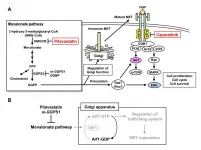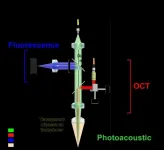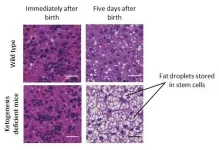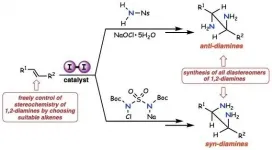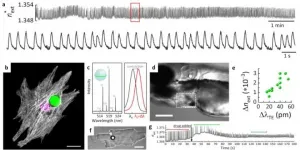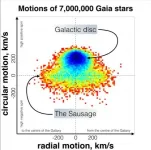Acoustic graphene plasmons study paves way for optoelectronic applications
The first images of mid-infrared optical waves compressed 1,000 times captured using a highly sensitive scattering-type scanning near-field optical microscope. -
2021-03-16
(Press-News.org) KAIST researchers and their collaborators at home and abroad have successfully demonstrated a new methodology for direct near-field optical imaging of acoustic graphene plasmon fields. This strategy will provide a breakthrough for the practical applications of acoustic graphene plasmon platforms in next-generation, high-performance, graphene-based optoelectronic devices with enhanced light-matter interactions and lower propagation loss.
It was recently demonstrated that 'graphene plasmons' - collective oscillations of free electrons in graphene coupled to electromagnetic waves of light - can be used to trap and compress optical waves inside a very thin dielectric layer separating graphene from a metallic sheet. In such a configuration, graphene's conduction electrons are "reflected" in the metal, so when the light waves "push" the electrons in graphene, their image charges in metal also start to oscillate. This new type of collective electronic oscillation mode is called 'acoustic graphene plasmon (AGP)'.
The existence of AGP could previously be observed only via indirect methods such as far-field infrared spectroscopy and photocurrent mapping. This indirect observation was the price that researchers had to pay for the strong compression of optical waves inside nanometer-thin structures. It was believed that the intensity of electromagnetic fields outside the device was insufficient for direct near-field optical imaging of AGP.
Challenged by these limitations, three research groups combined their efforts to bring together a unique experimental technique using advanced nanofabrication methods. Their findings were published in Nature Communications on February 19.
A KAIST research team led by Professor Min Seok Jang from the School of Electrical Engineering used a highly sensitive scattering-type scanning near-field optical microscope (s-SNOM) to directly measure the optical fields of the AGP waves propagating in a nanometer-thin waveguide, visualizing thousand-fold compression of mid-infrared light for the first time.
Professor Jang and a post-doc researcher in his group, Sergey G. Menabde, successfully obtained direct images of AGP waves by taking advantage of their rapidly decaying yet always present electric field above graphene. They showed that AGPs are detectable even when most of their energy is flowing inside the dielectric below the graphene.
This became possible due to the ultra-smooth surfaces inside the nano-waveguides where plasmonic waves can propagate at longer distances. The AGP mode probed by the researchers was up to 2.3 times more confined and exhibited a 1.4 times higher figure of merit in terms of the normalized propagation length compared to the graphene surface plasmon under similar conditions.
These ultra-smooth nanostructures of the waveguides used in the experiment were created using a template-stripping method by Professor Sang-Hyun Oh and a post-doc researcher, In-Ho Lee, from the Department of Electrical and Computer Engineering at the University of Minnesota.
Professor Young Hee Lee and his researchers at the Center for Integrated Nanostructure Physics (CINAP) of the Institute of Basic Science (IBS) at Sungkyunkwan University synthesized the graphene with a monocrystalline structure, and this high-quality, large-area graphene enabled low-loss plasmonic propagation.
The chemical and physical properties of many important organic molecules can be detected and evaluated by their absorption signatures in the mid-infrared spectrum. However, conventional detection methods require a large number of molecules for successful detection, whereas the ultra-compressed AGP fields can provide strong light-matter interactions at the microscopic level, thus significantly improving the detection sensitivity down to a single molecule.
Furthermore, the study conducted by Professor Jang and the team demonstrated that the mid-infrared AGPs are inherently less sensitive to losses in graphene due to their fields being mostly confined within the dielectric. The research team's reported results suggest that AGPs could become a promising platform for electrically tunable graphene-based optoelectronic devices that typically suffer from higher absorption rates in graphene such as metasurfaces, optical switches, photovoltaics, and other optoelectronic applications operating at infrared frequencies.
Professor Jang said, "Our research revealed that the ultra-compressed electromagnetic fields of acoustic graphene plasmons can be directly accessed through near-field optical microscopy methods. I hope this realization will motivate other researchers to apply AGPs to various problems where strong light-matter interactions and lower propagation loss are needed."
INFORMATION:
This research was primarily funded by the Samsung Research Funding & Incubation Center of Samsung Electronics. The National Research Foundation of Korea (NRF), the U.S. National Science Foundation (NSF), Samsung Global Research Outreach (GRO) Program, and Institute for Basic Science of Korea (IBS) also supported the work.
[Attachments] See images for this press release:
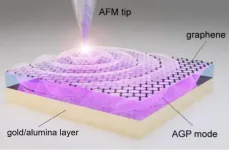
ELSE PRESS RELEASES FROM THIS DATE:
2021-03-16
An analysis has found deforestation is severely affecting forest bird species in Colombia, home to the greatest number of bird species in the world.
University of Queensland-led research, steered by Dr Pablo Negret, analysed the impact of deforestation on 550 bird species, including 69 only found in the South American nation.
"Our study has shown an astonishing reduction in bird species habitat," Dr Negret said.
"One third of the forest bird species in Colombia have lost at least a third of their historical habitat, and that's just using the most recent data we have available - from 2015.
"Moreover, 18 per cent or 99 species have lost more than half of their historical habitat to date.
"By 2040, we expect this will increase to 38 per cent or 209 species.
"Sadly, many of those ...
2021-03-16
A team of scientists led by Nanyang Technological University, Singapore (NTU Singapore) has developed a device that can deliver electrical signals to and from plants, opening the door to new technologies that make use of plants.
The NTU team developed their plant 'communication' device by attaching a conformable electrode (a piece of conductive material) on the surface of a Venus flytrap plant using a soft and sticky adhesive known as hydrogel. With the electrode attached to the surface of the flytrap, researchers can achieve two things: pick up electrical signals to monitor how the plant responds to ...
2021-03-16
Researchers from Tokyo Medical and Dental University (TMDU) uncover potential novel therapeutic strategies for oral and esophageal carcinomas
Tokyo, Japan - Discovering and treating tumors before they spread throughout the body is key for cancer patients to achieve positive outcomes. When tumor cells spread, which is known as metastasis, they can take over other organs and lead to death. Oral and esophageal carcinomas, or mouth and throat cancers, frequently metastasize to the lymph nodes. Unfortunately, there are currently no therapies that are specific to treating these particular cancers. Now, researchers at Tokyo Medical and Dental University (TMDU) identified several drugs ...
2021-03-16
A quadruple fusion optical and ultrasound imaging system has been developed that allows diagnosis of eye conditions or tumors or to see the environment inside the body using a transparent ultrasound transducer.
Professor Chulhong Kim of POSTECH's Department of Electrical Engineering, Convergence IT Engineering, and Mechanical Engineering, Dr. Byullee Park of Department of Convergence IT Engineering, Ph.D. candidate Jeongwoo Park of School of Interdisciplinary Bioscience and Bioengineering, Professor Hyung Ham Kim of Department of Convergence IT Engineering, and Professor Unyong Jeong of Department of Materials ...
2021-03-16
The research, by an international team from the Autonomous University of Madrid and the Technical University of Denmark, used 3D printing to create scaffolds for engineered flat brain organoids. The scaffolds allowed the brain organoid size to be significantly increased and after 20 days, self-generated folding was observed. END ...
2021-03-16
Military expenditures are highly counterproductive to green economic growth- documented by a recent study conducted by UrFU economist collaboration with an international research team. Sustainable economic development or green growth requires cleaner energy and green technology that can mitigate the negative externalities (e.g., carbon emission) of economic growth. The study utilized various macroeconomic indicators for 21 OECD countries over the year 1980-2016. This empirical study focusing on the dynamic impact of innovation, militarization and renewable energy on the green economy is published in the journal "Environmental Science and Pollution Research".
On the one hand, the military-industry (land vehicles, aircraft, and sea-vessels) consume a gargantuan ...
2021-03-16
Ketone bodies are generally an alternative energy source during starvation, but in newborns, ketogenesis is active regardless of nutritional status. In a recent study from END ...
2021-03-16
Osaka, Japan - Synthesizing pharmaceuticals for cancer, viral diseases, and other medical conditions is slow work. A particularly challenging chemical transformation is to start with what's known as an unactivated alkene--a common molecular building block--and end up with a vicinal diamine; i.e., installation of two nitrogen units into carbon--carbon double bonds. The result is a chemical unit that's present in medications for influenza and colorectal cancer.
Commonly, researchers must use rare, toxic metals and harsh reaction conditions to complete this transformation. Using a more sustainable catalyst for the reaction could solve such problems. Previous research has attempted to do so, ...
2021-03-16
Label-free optical sensors based on optical whispering-gallery-mode (WGM) microresonators exhibit extraordinary sensitivity for detecting physical, chemical, and biological entities, even down to single molecules. This extreme advancement in label-free optical detection is made possible by application of the optical microresonator, i.e. a 100 um glass microspheres, as optical cavity to enhance the detection signal. Akin to a spherical micromirror, the WGM cavity reflects the light by near-total internal reflection and thereby creates multiple cavity passes ...
2021-03-16
Note: The dwarf galaxy corresponding to the Gaia-Sausage structure of the Milky Way was named Enceladus by astronomers, after one of the hundred-handed giants in Greek mythology who opposed the rule of Zeus.
Looking up at the starry sky, the deep Universe appears quiet and mysterious. It is hard to imagine that the ancient dwarf galaxy Enceladus violently collided and was torn apart by our own Milky Way Galaxy, leaving behind the cries of a whole new generation of children from the hundred-handed giant. Recently, SCIENCE CHINA: Physics, Mechanics & Astronomy published an (Editor's Focus) article titled "Low-α Metal-rich stars with sausage kinematics in the LAMOST survey: Are they ...
LAST 30 PRESS RELEASES:
[Press-News.org] Acoustic graphene plasmons study paves way for optoelectronic applications
The first images of mid-infrared optical waves compressed 1,000 times captured using a highly sensitive scattering-type scanning near-field optical microscope. -


